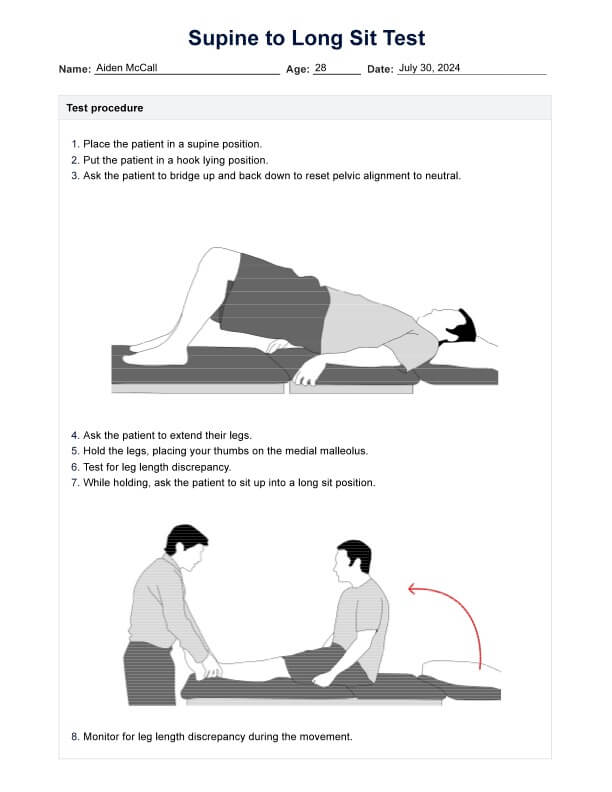Supine to Long Sit Test
Understand the Supine to Long Sit Test to screen for leg length discrepancy. Use our printable template for easy administration.


What is a Supine to Long Sit Test?
The Supine to Long Sit Test, also known as the supine to sit test or long sitting test, is an orthopedic physical assessment for identifying leg length discrepancy and possible dysfunction in the sacroiliac joints. During the test, the patient transitions from a supine (lying down) position to a long sit (sitting up with legs extended) position, allowing the examiner to observe any changes in leg length. This test helps differentiate between functional and structural leg length discrepancies.
However, it is important to note that the Supine to Long Sit Test has poor validity and reliability. Levangie in 1999 published research about several clinical tests (the standing flexion test, the Supine to Long Sit Test, the Seated Forward Flexion Test, and the Gillet Test. The research showed that the Supine to Long Sit Test and cannot consistently produce accurate or reliable results, making it less effective for clinical use. This research also showed that combining tests did not increase performance characteristics either. Research by Bemis and Daniel (1987) further supported this, reporting that the long sitting test has negative predictive values.
Despite these limitations, it can still be utilized as a screening tool to identify potential issues before conducting more definitive assessments.
How is this test conducted?
Here's how to do the test:
- Have the patient lie in a supine position.
- Place the patient in a hook lying position by bending their knees and placing their feet flat on the table.
- Ask the patient to perform a bridge by lifting their hips off the table and then returning to the starting position to reset pelvic alignment.
- Instruct the patient to extend their legs fully.
- Hold the patient's legs with your thumbs on the medial malleoli and observe for any discrepancies.
- Ask the patient to sit up into a long sit position while you continue to monitor leg length.
To more easily see how the test is conducted, consult our template. It contains images for the main positions assumed in the test.
How are the results interpreted?
A negative result indicates no discernible leg length discrepancy during the transition from supine to long sit position, suggesting that there is no significant functional leg length discrepancy or sacroiliac joint dysfunction.
A positive test is observed if there is a noticeable leg length discrepancy during the movement. This discrepancy suggests potential sacroiliac joint dysfunction or functional leg length discrepancy, where the apparent leg length changes due to pelvic or muscular imbalances rather than actual differences in bone length.
Supine to Long Sit Test Template
Supine to Long Sit Test Example
How to use our Supine to Long Sit Test template
To efficiently use our Supine to Long Sit Test template, follow these steps:
Step 1: Download the template
Click "Use template" to access the template on the Carepatron app, which will also let you customize it. Alternatively, you can download a non-customizable but printable PDF version by clicking the download button on this page.
Step 2: Familiarize yourself with the template and the test’s procedures
Review the template thoroughly and ensure you understand the test procedures, including patient positioning and monitoring for leg length discrepancies.
Step 3: Use the template
Conduct the test following the procedures outlined in the template. Record the patient’s information, test findings, and any additional notes during the examination.
Step 4: Analyze and interpret the test results
Compare the observed leg length discrepancies with the criteria provided in the template to determine whether the test result is positive or negative.
Because of this test's poor clinical usefulness, this test is best used as a screening, so you may want to do further testing, such as sacroiliac joint pain provocation tests like the posterior pelvic pain provocation test. You may also use radiography to take specific measurements of the discrepancy.
How orthopedists address leg length discrepancies
Orthopedists employ various methods to address leg length discrepancies, ensuring both immediate relief and long-term solutions for patients.
- Orthotic devices: Custom shoe inserts or lifts can help balance the discrepancy, providing immediate correction and reducing pain.
- Physical therapy: Targeted exercises can improve muscle strength and flexibility, addressing functional discrepancies, promoting better alignment, and improving joint mobility. Sports physical therapy works best for athletes who develop LLD in their career.
- Surgical intervention: In severe cases, surgical procedures such as limb lengthening or shortening can be performed to correct significant discrepancies.
- Chiropractic adjustments: Regular chiropractic care can help realign the pelvis and spine, particularly in cases of functional leg length discrepancy due to muscle imbalances or joint misalignments.
References
Bemis, T., & Daniel, M. (1987). Validation of the long sitting test on subjects with iliosacral dysfunction. Journal of Orthopaedic & Sports Physical Therapy, 8(7), 336–345. https://doi.org/10.2519/jospt.1987.8.7.336
Levangie, P. K. (1999). Four clinical tests of sacroiliac joint dysfunction: the association of test results with innominate torsion among patients with and without low back pain. Physical Therapy, 79(11), 1043–1057. https://pubmed.ncbi.nlm.nih.gov/10534797/
Commonly asked questions
The supine to sit test evaluates leg length discrepancy and identifying possible sacroiliac dysfunction by comparing leg lengths when a patient moves from lying down to sitting up.
Innominate rotation can be caused by muscle imbalances, trauma, poor posture, or repetitive stress on the pelvis.
Innominate posterior rotation is diagnosed through physical examination, assessing pelvic alignment, leg length discrepancies, and patient history.
Anterior innominate rotation can be corrected through physical therapy, targeted exercises to strengthen and balance pelvic muscles, and chiropractic adjustments.







































































































